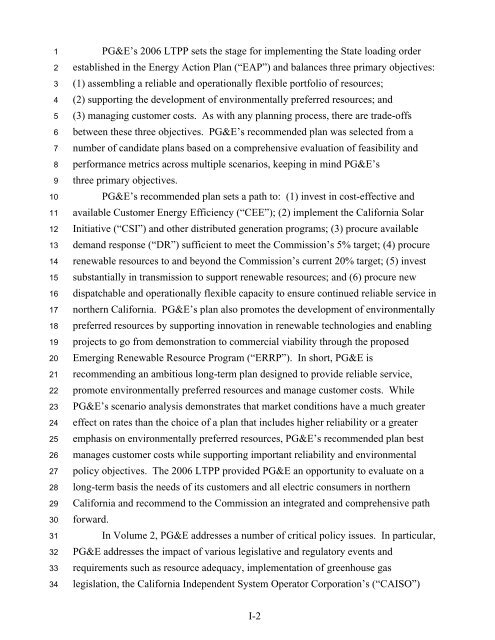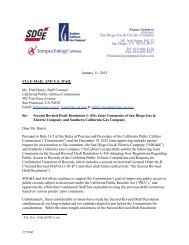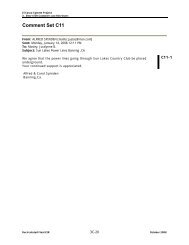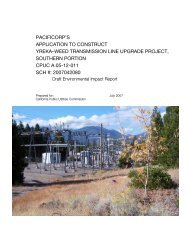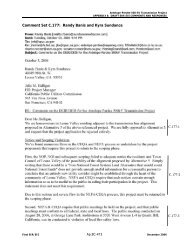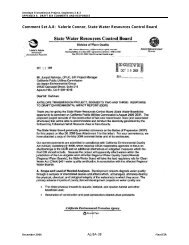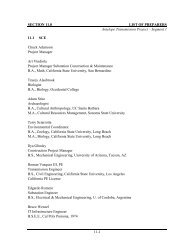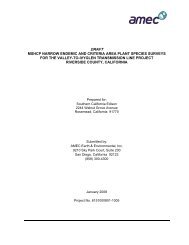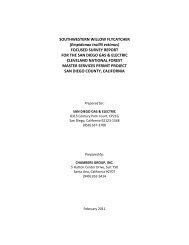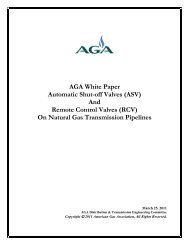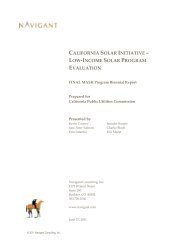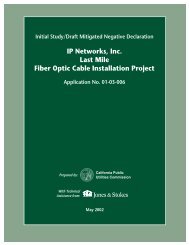Volume I. Part I - California Public Utilities Commission
Volume I. Part I - California Public Utilities Commission
Volume I. Part I - California Public Utilities Commission
You also want an ePaper? Increase the reach of your titles
YUMPU automatically turns print PDFs into web optimized ePapers that Google loves.
1<br />
2<br />
3<br />
4<br />
5<br />
6<br />
7<br />
8<br />
9<br />
10<br />
11<br />
12<br />
13<br />
14<br />
15<br />
16<br />
17<br />
18<br />
19<br />
20<br />
21<br />
22<br />
23<br />
24<br />
25<br />
26<br />
27<br />
28<br />
29<br />
30<br />
31<br />
32<br />
33<br />
34<br />
PG&E’s 2006 LTPP sets the stage for implementing the State loading order<br />
established in the Energy Action Plan (“EAP”) and balances three primary objectives:<br />
(1) assembling a reliable and operationally flexible portfolio of resources;<br />
(2) supporting the development of environmentally preferred resources; and<br />
(3) managing customer costs. As with any planning process, there are trade-offs<br />
between these three objectives. PG&E’s recommended plan was selected from a<br />
number of candidate plans based on a comprehensive evaluation of feasibility and<br />
performance metrics across multiple scenarios, keeping in mind PG&E’s<br />
three primary objectives.<br />
PG&E’s recommended plan sets a path to: (1) invest in cost-effective and<br />
available Customer Energy Efficiency (“CEE”); (2) implement the <strong>California</strong> Solar<br />
Initiative (“CSI”) and other distributed generation programs; (3) procure available<br />
demand response (“DR”) sufficient to meet the <strong>Commission</strong>’s 5% target; (4) procure<br />
renewable resources to and beyond the <strong>Commission</strong>’s current 20% target; (5) invest<br />
substantially in transmission to support renewable resources; and (6) procure new<br />
dispatchable and operationally flexible capacity to ensure continued reliable service in<br />
northern <strong>California</strong>. PG&E’s plan also promotes the development of environmentally<br />
preferred resources by supporting innovation in renewable technologies and enabling<br />
projects to go from demonstration to commercial viability through the proposed<br />
Emerging Renewable Resource Program (“ERRP”). In short, PG&E is<br />
recommending an ambitious long-term plan designed to provide reliable service,<br />
promote environmentally preferred resources and manage customer costs. While<br />
PG&E’s scenario analysis demonstrates that market conditions have a much greater<br />
effect on rates than the choice of a plan that includes higher reliability or a greater<br />
emphasis on environmentally preferred resources, PG&E’s recommended plan best<br />
manages customer costs while supporting important reliability and environmental<br />
policy objectives. The 2006 LTPP provided PG&E an opportunity to evaluate on a<br />
long-term basis the needs of its customers and all electric consumers in northern<br />
<strong>California</strong> and recommend to the <strong>Commission</strong> an integrated and comprehensive path<br />
forward.<br />
In <strong>Volume</strong> 2, PG&E addresses a number of critical policy issues. In particular,<br />
PG&E addresses the impact of various legislative and regulatory events and<br />
requirements such as resource adequacy, implementation of greenhouse gas<br />
legislation, the <strong>California</strong> Independent System Operator Corporation’s (“CAISO”)<br />
I-2


